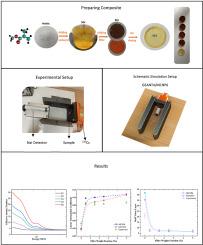PMMA reinforced with high-Z fillers for gamma radiation shielding: synthesis and Monte Carlo simulations
IF 4.5
2区 化学
Q2 POLYMER SCIENCE
引用次数: 0
Abstract
Polymer composites are increasingly being explored for radiation shielding relying on their light weight, ease of manufacturing, and flexibility. Poly (methyl methacrylate) (PMMA), which is already widely used in medical and industrial applications, was selected for this study due to its transparency and stability. The goal was to investigate how well PMMA can attenuate gamma radiation, both on its own and when reinforced with high-Z fillers.
For the filler, a balanced mix of cadmium oxide (CdO) and mercury oxide (HgO) was used. Samples were prepared using a simple solution casting method and tested using a137Cs gamma source (10 μCi). To support the experimental results, Monte Carlo simulations were also carried out using MCNP6 and GEANT4. Attenuation properties such as linear and mass attenuation coefficients (LAC, MAC), mean free path (MFP), half- and tenth-value layers (HVL, TVL), and transmission factor (TF) were calculated. Software tools like XCOM and Ph-X were used for additional analysis, including effective atomic number calculations. Structural features of the materials were also examined using XRD and FESEM techniques.
The results from experiments and simulations were in good agreement. Even a small amount of filler noticeably improved the radiation shielding performance. At low filler levels and sample thicknesses, the material remained transparent, while higher filler content led to better attenuation. Overall, the composite showed strong potential as a practical material for gamma radiation shielding.

用高z填料增强的PMMA用于伽马辐射屏蔽:合成和蒙特卡罗模拟
聚合物复合材料由于其重量轻、易于制造和灵活,越来越多地被用于辐射屏蔽。聚甲基丙烯酸甲酯(PMMA)已广泛应用于医疗和工业应用,由于其透明度和稳定性而被选择用于本研究。目的是研究PMMA在单独使用和使用高z填料增强时对γ辐射的衰减效果。
本文章由计算机程序翻译,如有差异,请以英文原文为准。
求助全文
约1分钟内获得全文
求助全文
来源期刊

Polymer
化学-高分子科学
CiteScore
7.90
自引率
8.70%
发文量
959
审稿时长
32 days
期刊介绍:
Polymer is an interdisciplinary journal dedicated to publishing innovative and significant advances in Polymer Physics, Chemistry and Technology. We welcome submissions on polymer hybrids, nanocomposites, characterisation and self-assembly. Polymer also publishes work on the technological application of polymers in energy and optoelectronics.
The main scope is covered but not limited to the following core areas:
Polymer Materials
Nanocomposites and hybrid nanomaterials
Polymer blends, films, fibres, networks and porous materials
Physical Characterization
Characterisation, modelling and simulation* of molecular and materials properties in bulk, solution, and thin films
Polymer Engineering
Advanced multiscale processing methods
Polymer Synthesis, Modification and Self-assembly
Including designer polymer architectures, mechanisms and kinetics, and supramolecular polymerization
Technological Applications
Polymers for energy generation and storage
Polymer membranes for separation technology
Polymers for opto- and microelectronics.
 求助内容:
求助内容: 应助结果提醒方式:
应助结果提醒方式:


